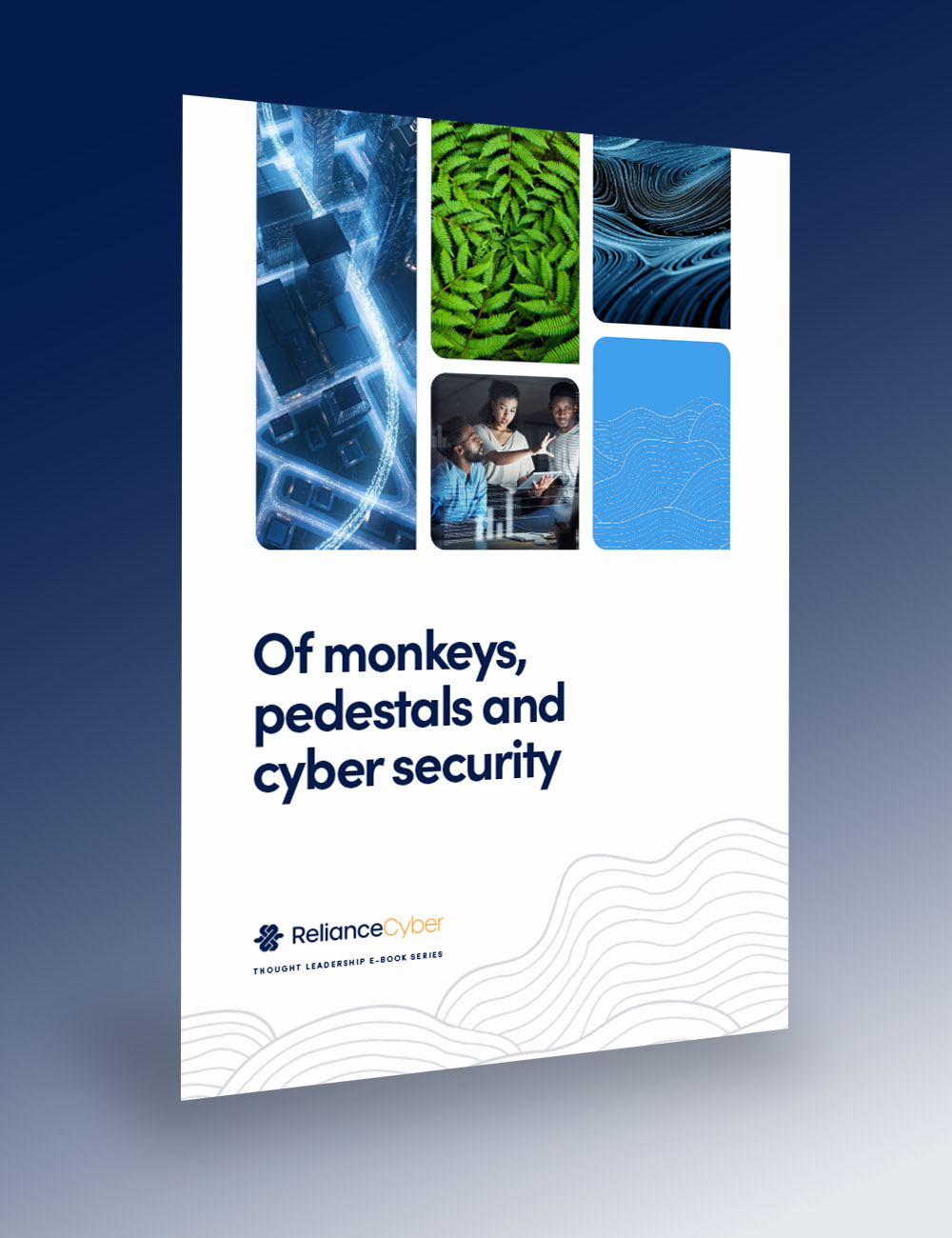Want to download this article? Click here
Focus your energy on the controls that actually stop cyber attacks. Perfect policies, risk reports, and maturity frameworks might look good, but they don’t block threats. Get your defences solid first — then build your pedestals.
Introduction
There’s a beautiful metaphor about how human nature often guides us to do things in order of ease, rather than in order of priority. It goes like this:
Imagine your team is tasked with teaching a monkey to juggle flaming torches while standing atop a 12-foot pedestal. What do you do first?
The right answer lies in assessing critical path and risk. 99.99% of the risk to this project’s success lies in training the monkey. Building a pedestal is easy; we’ve been doing it for millennia. So, logically, we should spend all our effort on the monkey, and only worry about the pedestal once we know the monkey is making clear progress.
But that’s not what usually happens, especially in corporate settings. Instead, we build the pedestal first. Why?
- Because it’s a clear deliverable. It shows progress: “Yeah boss, we’re working on the monkey, but check out this awesome pedestal.”
- Because even if the project fails, we can still say we achieved something: “Shame about the monkey, but hats off to the pedestal team.”
This thinking is flawed. If the monkey fails, the pedestal is pointless. (Unless you’re a pedestal manufacturer, in which case… carry on.)
Applying the metaphor to cyber security
In conversations with CISOs, IT directors, customers, suppliers and peers, I frequently see this metaphor play out in cyber security.
Too often, we place far more emphasis on governance, reporting, and risk documentation, while neglecting the hands-on work that truly protects our organisations. Let me explain.
Cyber security, at its core, is about preventing unauthorised access, damage, or disruption to digital assets. Success is when attackers get nothing. Failure is when our business is wiped out by a breach. The difference lies in whether our defences are effective. Consider this breakdown:
Monkeys (Hard Problems)
Pedestals (Less Hard Problems)
Ensuring 100% EDR coverage and robust configuration
Arranging a third-party security maturity assessment
Remediating vulnerabilities with a constant downward trend
Completing a risk register for audit
Securing the SDLC to minimise software risk
Producing and distributing security policies
Improving email gateway threat blocking
Creating risk reports for the board
The right-hand column isn’t unimportant or effortless. But these are well-trodden paths. Writing a security policy? Tens of thousands have done it. Achieving near-zero vulnerabilities at scale? That’s rare. That’s meaningful. And it directly impacts breach prevention.
In cyber, we’re facing purely technical threats. Threat actors simply don’t care about your risk register, policies, or maturity score. Somewhat ironically, they might well steal or encrypt those documents, but they certainly won’t be deterred by them. So don’t be tempted to spend all your energy on the right-hand side. Particularly the energy of your most senior and experienced cyber security people – which is so often the case in my personal experience.
“The metaphor doesn’t suggest ignoring the pedestal altogether. It suggests not starting there when the monkey is still accidentally setting itself on fire.”
Addressing the counterarguments
Counter-argument A:
We need policies and standards first, so we know how to configure our controls.
It’s a fair point. In an ideal world with abundant resources and a break from threat actors, we could build all the frameworks first. But that’s rarely the case. Often, doing Thing A means Thing B doesn’t get done.
Developing policies is inward-facing, requires heavy stakeholder involvement, and takes time to enact meaningful change. Meanwhile, there are proven best practices for improving defences that most organisations can act on immediately.
Almost everyone has firewalls, IDPs, and some kind of EDR. But almost no audit I’ve seen shows these configured without gaps. And when scanning external attack surfaces, HIGH or CRITICAL vulnerabilities are nearly always present.
You can start improving these controls right now. No matter what tool or technology you use today, there’s documentation and guidance (normally available for free from the vendor) on how to configure it properly. Or ask us. That will protect you far more than any policy document. And it might give you the breathing room to focus on governance later. Remember: The metaphor doesn’t suggest ignoring the pedestal altogether. It suggests not starting there when the monkey is still accidentally setting itself on fire.
Counter-argument B:
Without risk management, how do we know where we’re weak and what to prioritise?
Another strong argument, and yet the same principle applies. If security teams were really well resourced and if threat actors would just give us a break for a few months while we get our ducks in a row, it would be bullet proof.
More realistically, unless you’re a giant, complex enterprise, two questions can go a long way:
- What systems and data are most critical to the business?
- How are companies like ours getting breached?
Answering those questions in any company of less than a few thousand employees should be trivial. So, if ransomware is common in your sector, and your critical systems are on-prem, you can immediately start hardening those systems.
Take EDR, for instance. You don’t need a risk workshop to conclude:
- You need EDR on every compatible asset.
- It must be correctly configured to detect and prevent threats.
If that’s not true today, make it true fast. Bring in help if needed. Our incident response teams never see ransomware succeed where EDR is well-deployed and configured.
Or take a firewall. You don’t need a risk workshop to conclude:
- ANY/ANY rules are bad without exception
- Allowing plaintext protocols must always be avoided
- You need to make sure that all known CVEs are patched.
You can normally fix these things quickly and for free. So start there. Need board-level justification or risk messaging for support, expertise or funding? We can give you that tomorrow.
“It’s a fair point. In an ideal world with abundant resources and a break from threat actors, we could build all the frameworks first. But that’s rarely the case.”

Summary
At Reliance Cyber, we believe that cyber security is increasingly an engineering discipline. In 2025, organisations are under constant threat. Governance matters. Policies matter. But none of them stop an exploit on an exposed port.
Focus first on the monkey: tighten your controls, eliminate obvious weaknesses, and make your defensive tools work properly.
You don’t need perfect standards to shut down insecure firewall rules. You don’t need board approval to patch a vulnerable system. You just need to start.
And once the monkey is juggling safely, then go build that pedestal.

Written by: Alex Martin
Director of Managed Services
Alex, with 18 years in Intelligence and Cyber Security, advanced from managing the XDR SOC to Director of Managed Services at Reliance Cyber. His expertise spans Incident Response, Compliance, and SOC/NOC operations.

Download the full article
This article is available as a downloadable pdf e-book. To access this file, please click the button below.
About Reliance Cyber :
Reliance Cyber delivers world class cybersecurity services tailored to the unique needs of our customers. With extensive in-house expertise and advanced technology, we protect organisations across a wide range of sectors — from enterprise to government —against the most sophisticated threats, including those from nation-state actors. Our teams safeguard critical assets, people, data, and reputations, allowing customers to focus on their core business objectives with confidence.
Get in touch with our experts
+44 (0)845 519 2946
contact@reliancecyber.com

